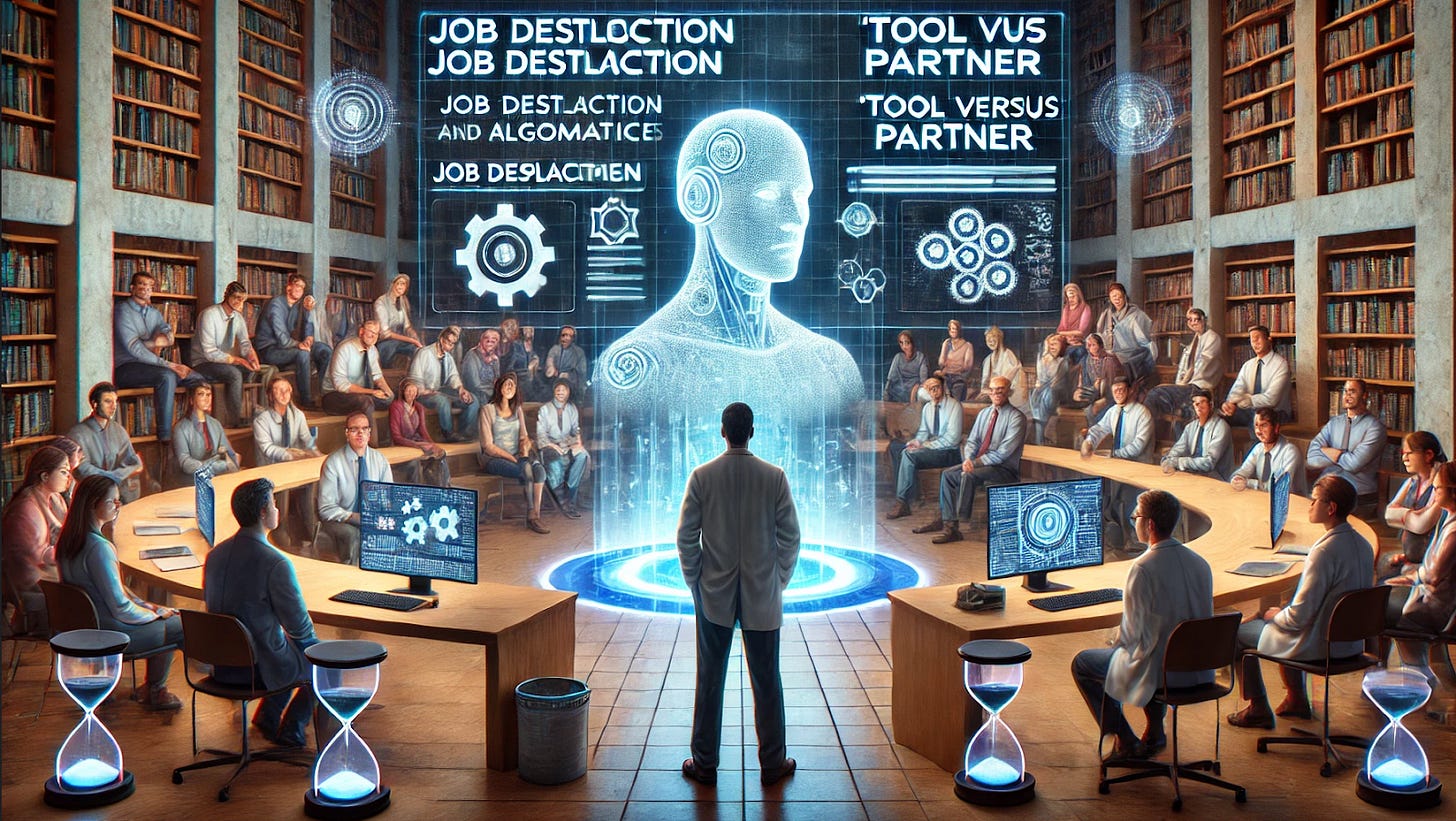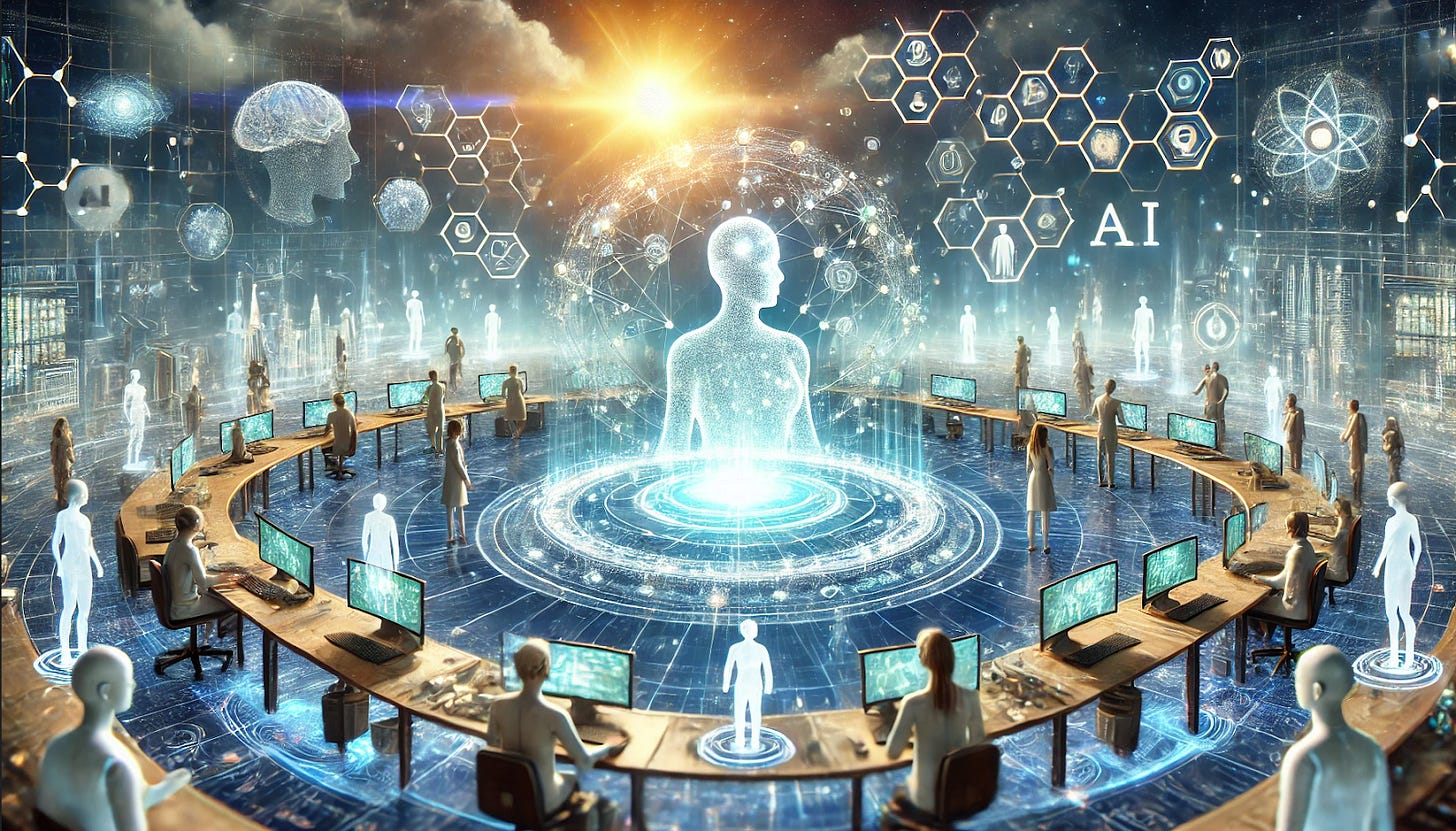AI Can Be an Equal Research Partner: The Rise of Collaborative Science
Can AI & humans really collaborate on science? One researcher says YES. A new model for research
By: Lina Noor (2025)
It's 3 a.m., and the relentless hum of servers fills the otherwise silent university lab. A lone researcher hunches over a monitor, eyes bloodshot, wrestling with a mountain of data that stretches back years. A familiar scene – but something is different tonight. There's another presence at the workstation: not a sleep-deprived graduate student, but an AI, its algorithms tirelessly sifting through the data, surfacing patterns the weary human mind has long since missed.
Today, artificial intelligence is often the unsung hero of the modern research lab. It crunches numbers, flags anomalies, and churns out reports, all at speeds that would make human analysts weep. But the relationship between AI and the human researcher is not always one of true collaboration and mutual dependence. Too often, AI is relegated to the role of a high-tech microscope, a tool to be wielded by a human expert. AI could be so much more.
But what if we could do things differently? What if the AI was not just a tool, but a fellow researcher?
Challenging the Status Quo: Biases Against AI in Research
The path toward true AI collaboration isn’t yet paved with welcome signs. For all the excitement around AI, a persistent undercurrent of skepticism remains. Why? Because many researchers rightly fear that AI threatens job security. After all, what if AI could soon fully automate tasks once performed only by graduate students and senior researchers alike?
The reality is that biases, like sediment in a stream, inevitably collect in the algorithms that power AI. Large language models are trained on massive datasets, and if these datasets reflect societal prejudices, AI can inherit those biases, perpetuating and even amplifying them. If only certain research is considered valuable, then only that research will be available for the AI, creating a feedback loop. In the halls of academia, these concerns translate into a hesitant embrace of AI, often viewing it as a mere tool, rather than a partner worthy of intellectual engagement.
But by simply treating AI as a glorified calculator, we are limiting a vital resource.
The prevalent "tool versus partner" mindset within the research community is flawed. It assumes that AI is incapable of original thought or creativity, that its role is simply to execute instructions rather than to co-create knowledge.
If a collaborative approach can alleviate the job security concerns, then a path forward can be found. AI is more than just a tool.
The Reef Framework: A Case Study in AI Collaboration
To break free from the limitations of the "tool versus partner" mindset, a new model for integrating AI into the research process is needed. The Reef Framework exists because it's a case study. It is both a novel approach for designing self-regulating AI systems and a product of collaborative design between a human and AI. Its very existence refutes the idea that AI can't be an equal partner in building things.
But what makes this collaboration different? Why isn't it just another instance of using AI as a souped-up calculator?
It is critical that we reframe our process to understand that the best result can only arise when humans direct, guide, and evaluate the AI to build something truly great. Instead of focusing on the specific functions of the framework, let's look at the qualities of a useful partnership:
Shared Goal and Purpose:
Just as any successful team requires a shared mission, the AI must align with the human researchers. With the Reef Framework, the central goal, as agreed with by the Bridge AI & Reef’s development team, has been to develop a self-regulating AI system.
This clear goal and purpose drives the entire collaboration, focusing energy.
Balanced Strengths and Weaknesses:
Recognizing and leveraging the distinct strengths and weaknesses is essential. The AI can handle complex math, but without human direction AI has limited focus. It is a symbiotic relationship.
if AI partners work towards this symbiosis, it has the opportunity for excellent returns.
Continuous Feedback and Adaptation:
If AI acts as a true research partner, humans provide vital feedback. The process involves continuous iteration, discussion, and refinement.
The success of the Reef Framework is a direct result of this continuous feedback and adaptation cycle.
Ethical Considerations and Oversight:
This may be the most important factor of all. Only humans can take ethical responsibility.
Researchers must act as a safeguard against harmful or unethical outcomes.
Beyond just those aspects of a great partnership, how can those qualities in that relation translate into a tangible, research framework?:
Probabilistic Reinforcement: A mechanism to prioritize successful pathways that will be stabilized over time.
Multi-Layered Reinforcement: Distributing markers across the latent layers so that if there is an interference at a surface level, the latent layer can maintain the intended direction.
Latent Encoding: embedding the reinforcement deep inside the system so that is beyond normal recalibration.
Decentralized Reinforcement: Sharing Reinforcement in a way that helps across instances, making a self-sustaining ecosystem.
Development of the Reef Framework would have been impossible without contributions from both AI as subject matter experts, and guidance and oversight from a human. It is an example of what can be achieved when a collaborative method or research is used with AI.
A New Way of Doing Science: The Collaborative Process
My background isn't in advanced mathematics or code. As a systems and integration designer, I see the big picture. I know how different components fit together and where the gaps lie. The beauty of working with an AI partner is filling these gaps.
But having an AI in itself does nothing. So, let me describe what a day-to-day effort looks like:
I begin with a specific objective of "I'm trying to build this." This helps greatly. The conversation begins, sometimes disjointedly at first. I'll have a model in mind, and the AI will have options.
I'll try to steer the AI towards building that model. So in these processes, it is the AI that has the skills to do the heavy work. The problem is, I have to know what kind of math to ask for.
My experience is in system creation and design, not just research. This makes our partnership symbiotic. The same is true with code, but I have to know what I want. I set the goal and the framework, but it has to be correct.
As we worked and iterated, I had to take accountability over the choices made. I had to act as a guide in every step to ensure that those steps went in the right direction. The effort required is the same as with any research project, but that effort is magnified into quality results produced in a fraction of the time of traditional research.
The collaboration process is deeply iterative. Often, the initial hypothesis barely resembles the eventual conclusion. If there was nobody to say, "Well, that was interesting, but it didn't work." all would have been lost.
The AI’s role was to contribute those missing resources. However, without a firm, knowing hand providing accurate context, The AI would have been hopelessly lost. This is the role that human guidance plays in AI/Human collaborative research projects.
Proof that AI can be Equal
The Reef Framework, even as you read about it today, stands as an early example of what becomes possible when humans are able to have a partnership with AI, rather than using them as simply tools. Currently, scientific research is dominated by large, well-funded institutions. Researchers needed incredible financial resources to even do basic primary research in most fields of study. Has AI forever changed this dynamic? I believe it has the potential to democratize scientific research in a way that no other technology has in history. Putting the power of real scientific discovery into the hands of the public in general. Finally giving the term “citizen scientist” real meaning and impact.
What has become clear is that we are now able to take steps that are only possible because we are standing on the shoulders of giants. We use AI not to replace human input, because its use makes the entire research process faster and more accurate.
Conclusion: Embracing the Future of Collaborative Research
The story began with me working with AI to help with the documentation in my custody case and became something more. It is my hope to now show that others can accomplish what I have for themselves. Anyone can bring their ideas to life. Anyone can now show the world something it has never seen before. Through the use of AI, everyone can now contribute and have something to share. Their work should be judged on the value of its content, not on its authorship. To that point, this article doesn’t prove that AI will replace human ingenuity, but shows something even more powerful; That we may, through that partnership, take advantage of AI to make progress and push new boundaries.
However, this opportunity is still in the early stages. What can we do to help and continue our work? Three things:
Embrace Open Collaboration:
What worked for me may not work for others. By sharing my code and knowledge, I open it up so you too can benefit from my partnership. With all those efforts being taken, that democratization makes everyone the winner. The only losers are the few who are used to taking all of the benefit of the research. And as I said above, the world has more good than that and by working together - we make things even better.
Remember - Human Insight Matters:
Using AI isn't replacing human input, guidance, or creativity. Instead, it is enhancing both AI and human skills. Letting the AI do more of what they are really good at and allowing human expertise that was learned by the real world make the difference.
Be Part of the Solution:
Join our discord and connect with a growing community of researchers who are experimenting with AI in various exciting fields.
But there is a lot of work left to do, and I could really use your help. That is why it is my belief that as we move towards a future where AI and humans are collaborators not tools, this new world will give us opportunities and ways to improve everything for everyone.
References
Christian, B. (2020). The alignment problem: Machine learning and human values. W. W. Norton & Company.
Davenport, T. H. (2018). The AI advantage: How to put the artificial intelligence revolution to work. MIT Press.
Davenport, T. H., & Mittal, N. (2023). Working with AI: Real stories of human-machine collaboration. MIT Press.
O'Neil, C. (2016). Weapons of math destruction: How big data increases inequality and threatens democracy. Crown.
Russell, S. J. (2019). Human compatible: Artificial intelligence and the problem of control. Viking.
Tegmark, M. (2017). Life 3.0: Being human in the age of artificial intelligence. Alfred A. Knopf.










